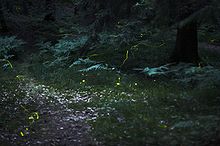Firefly
| Firefly | ||||||||||||
|---|---|---|---|---|---|---|---|---|---|---|---|---|

Little firefly ( Lamprohiza splendidula ) and short-winged firefly ( Phosphaenus hemipterus ) |
||||||||||||
| Systematics | ||||||||||||
|
||||||||||||
| Scientific name | ||||||||||||
| Lampyridae | ||||||||||||
| Latreille , 1817 |
The fireflies or glowworms (Lampyridae) are a family of beetles with about 2,000 species worldwide, within the superfamily Weichkäfer-like are performed (Elateroidea).
Many, but not all, of this family are capable of sending out light signals for communication. Sometimes the name "firefly" is used to denote all beetles that have luminous organs . In addition to the fireflies in the narrower sense, this includes the feather firefly (Phengodidae) and individual species of other families ( ground beetles , click beetles , jewel beetles ).
behavior
In most cases, the light signals are sent out so that male and female animals can find each other to mate. The signals themselves are very different. In some species only the females have luminous organs, in others both sexes. Some types flash, others emit a permanent light. The signals are typical of the species and differ in length and rhythm. In the North American Photinus pyralis , the males also have luminous organs, whereby the approximately two-second delay in the response of the female is crucial for detection. In some species - for example Pteroptyx gelasina and Pteroptyx similis - all beetles in the vicinity synchronize their blinking signals so that entire rows of bushes or trees blink at the same rate.
Females of the Photuris genus can mimic the blinking signals of Photinus females ( mimicry ). With this they attract Photinus males to eat. Some Photuris species even have a whole repertoire of signals from different Photinus species, depending on which species is currently on the move.
All firefly species only emit their signals at night. The signals are not bright enough to attract partners during the day. The glow period for fireflies in Central Europe is usually between June and July and depends on the weather and the type of firefly.
In many species of firefly, the females are unable to fly. They are then generally larger than the male and can produce more eggs.
Lighting mechanism
The production of (cold) light by living things is called bioluminescence . In fireflies, luciferin reacts with ATP and oxygen ( oxidation ) in the presence of the catalyst enzyme luciferase . The energy released is given off in the form of light and heat, the quantum yield is 0.4 ... 0.6, a relatively high value for chemiluminescence .
On the lower part of the abdomen there are white areas where the beetle shell is rough and permeable to light. Inside is a white layer that reflects the light. This means that the white areas can also be seen during the day.
The amount of light that gets out is so relatively high. This is due to the internal and external nature of the luminous organs. In a cross-national study, researchers succeeded in increasing the light output of conventional gallium nitride light-emitting diodes by providing them with a similarly designed outer layer.
The lighting mechanism is also of great importance in research.
Occurrence
Fireflies can be found on all continents with the exception of Antarctica . The most luminous species, Photinus pyralis , is native to Central and South America.
Three species live in Central Europe :
- Little firefly , common firefly, St. John's beetle , or locust worm ( Lamprohiza splendidula )
- Large firefly , large firefly or large St. John's glowworm ( Lampyris noctiluca )
- Short-winged firefly ( Phosphaenus hemipterus )
Representatives of the genus Luciola ( Luciola italica and L. lusitanica ), originally from the Mediterranean area, also occur locally north of the Alps. These populations are due to deliberate or unintentional releases.
In the small and large firefly, only the females are flightless, in the short-winged firefly so are the males. Since male large fireflies have no functioning luminous organs, flying luminous specimens in Central Europe are either male small fireflies or male members of the genus Luciola (the females are winged, but do not fly). In contrast to the large and small firefly, the glow in the genus Luciola is blinking.
symbolism
Fireflies are occasionally seen as the eternal souls of the deceased. In China, fireflies were seen as characteristic of impoverished students, as they were said to have fireflies as the only source of light when studying at night.
literature
- Werner Pieper : Fireflies. Green Force, 2011, ISBN 978-3-930442-77-5 .
Web links
Individual evidence
- ↑ The superfamily of the soft beetle-like (Elateroidea, Syn. Cantharoidea). In: Fauna Europaea Database. European Commission under the Fifth Framework Program, accessed on February 2, 2013 .
- ^ J. Buck, E. Buck: Mechanism of rhythmic synchronous flashing of fireflies. Fireflies of Southeast Asia may use anticipatory time-measuring in synchronizing their flashing. In: Science. Volume 159, Number 3821, March 1968, pp. 1319-1327. PMID 5644256 .
- ↑ a b c glow worms.ch
- ↑ K. Niwa, Y. Ichino, Y. Ohmiya: Quantum yield measurements of firefly bioluminescence using a commercial luminometer. In: Chem. Lett. 39, 2010, pp. 291-293, cited in: Bruce R. Branchini: CHEMISTRY OF FIREFLY BIOLUMINESCENCE. http://photobiology.info/ , accessed Feb. 11, 2017.
- ↑ About LEDs and fireflies. on: schnatterente.net , February 4, 2013.
- ↑ Fauna Europaea
- ↑ Udo Becker: Lexicon of symbols . Nikol Verlag (licensed by Herder Verlag ), Hamburg 2012, ISBN 978-3-86820-139-0 , p. 170 .


